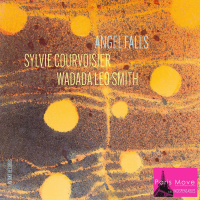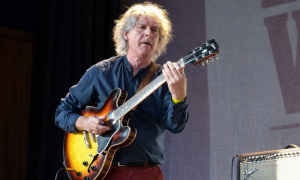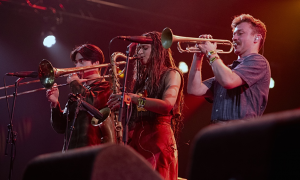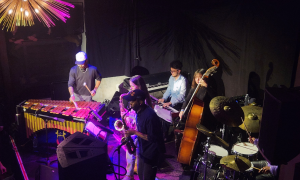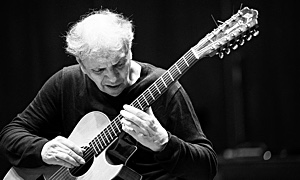Home » Jazz Articles » Live Review » Montreal Jazz Festival Day 6: July 3, 2007
Montreal Jazz Festival Day 6: July 3, 2007
The middle day of the Festival International de Jazz de Montreal is typically a transitional day with no indoor ticketed events. Instead, vistors get to choose from a series of free shows on the seven outdoor stages, situated throughout six square city blocks that are closed off during the festival, in the heart of the city's downtown.
This year Day Six broke from convention by featuring one ticketed event—the legendary Van Morrison, but the real attraction was the festival's second of three Grand Évenément General Motors (General Motors Big Events), taking place on the largest outdoor stage, Scéne General Motors. The festival is renowned for a palpable vibe that, despite the sometimes massive numbers of people on the streets, carries assurances that it's not just safe, it's relaxed and friendly. Day Six's Grand Évenément featured singer/saxophonist Seun Kuti and his fifteen-piece Egypt '80 group in a hundred-minute performance that combined booty-shaking Afrobeats with the kind of outdoor spectacle for which the festival is famous the world over. Where else can you find, at times, over 100,000 people on the street, yet security and crowd control being so well-executed (and, for the most part, completely invisible) that all a vistor has to do is get excited and have a great time?

Seun Kuti & Egypt '80
Kuti is the son of the late Fema Kuti, and after an introductory instrumental led by the group's baritone saxophonist, he took to the stage for a show that focused on the music of his father and his own original songs. Politically charged, but in the best possible way, the show was a celebration of African culture while delivering strong messages about the seemingly insurmountable challenges facing its people. At one point Kuti introduced a song by explaining, "In my country [Nigeria], the people don't think about politics, they don't think about sociology, they just try to survive." In another introduction he spoke about a bridge, underneath which he found people "pissing in the water, shitting in the water, bathing in the water, drinking the water..." The message was crystal clear, but delivered through such infectious music that, rather than proselytizing with a big stick, Kuti engaged the audience in a positive way making his message all the stronger.
With a large band consisting of baritone and tenor saxophonists (in addition to Kuti's alto), trumpet, two guitars, bass, drums, four percussionists and three backup singers (and, late in the set, an additional six dancers), the grooves were relentlessly upbeat and joyous, though the set was organized so that it flowed naturally and dynamically from start to finish. The wealth of polyrhythms from the drummer and percussionists created powerful rhythms that had the audience of over 100,000 dancing the entire time. While the songs could be considered simplistic, consisting almost entirely of long vamps, the arrangements were so vivid, so bright and buoyant that they never wore out their welcome. Kuti himself is a charismatic figure yet he was able to direct the audience' attention to other parts of the stage, ensuring that all the members of the group, at some point, were in the spotlight.

While there was the expected audience participation, clapping and singing along to some of the songs, the most memorable moment was when Kuti encouraged the audience to get out their cellphones, turn them on, and raise them in the air. Watching tens of thousands of people do it set a new precedent, eliminating the days of lighting a match or holding a lighter, to be replaced now with the longer-lasting (and brighter) lights of electronic devices.
Throughout the show there were visuals happening everywhere you looked. On scaffolds throughout the festival site additional dancers, in increasing numbers, were spotlighted high in the air. Images, including an animated Afrobeat logo and the message "Music is the Weapon," were projected onto the side of the Hyatt Regency hotel, while a sophisticated lighting show kept things exilharating onstage. At the start of the show, when the baritone saxophonist brought the band on one-by-one, a brief firework explosion above the stage matched each new introduction.


But the best, as always, was saved for last. Clearly confident that the audience wouldn't let them go without at least one encore, the finale featured a fireworks show scattered throughout the site. It wasn't just impressive in its scope, but also in the way that the fireworks were synchronized with the music. The festival's Grand Évenément presentations have always been about spectacle, but what is most remarkable is how, year after year, they manage to create for ever larger crowds larger-than-life events that are always distinct and highly memorable. Anyone who was on the street for Seun Kuti & Egypt '80 went home from an experience that will not be forgotten soon.
Tomorrow: Richard Bona with the Jaco Pastorius Big Band and the John Abercrombie Third Quartet.
Visit Seun Kuti and the Festival International de Jazz de Montreal on the web.
Photo Credit
John Kelman
Day 1 | Day 2 | Day 3 | Day 4 | Day 5-1 | Day 5-2 | Day 6 | Day 7 | Day 8 | Day 10 | Day 11
Tags
PREVIOUS / NEXT
Support All About Jazz
 All About Jazz has been a pillar of jazz since 1995, championing it as an art form and, more importantly, supporting the musicians who make it. Our enduring commitment has made "AAJ" one of the most culturally important websites of its kind, read by hundreds of thousands of fans, musicians and industry figures every month.
All About Jazz has been a pillar of jazz since 1995, championing it as an art form and, more importantly, supporting the musicians who make it. Our enduring commitment has made "AAJ" one of the most culturally important websites of its kind, read by hundreds of thousands of fans, musicians and industry figures every month.








